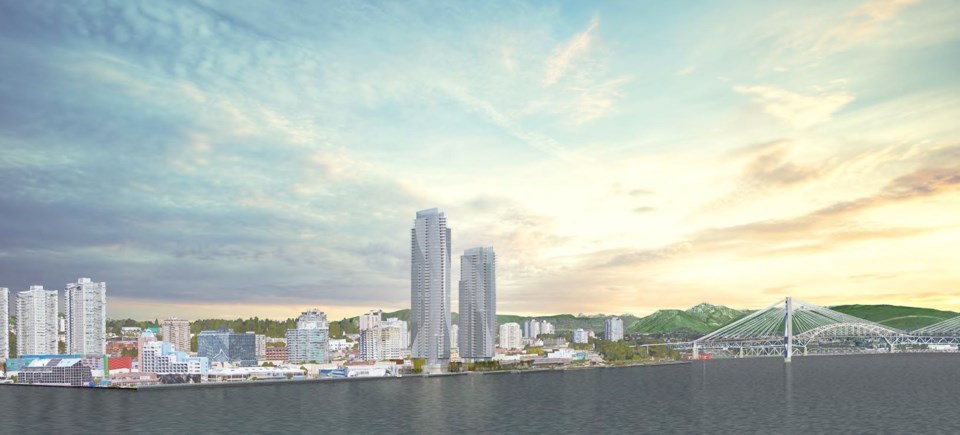Bosa Development has firmed up its plans for a monolithic concrete pour at the Pier West site on New Westminster’s waterfront.
City council has granted Bosa Development an exemption to the construction noise bylaw from 6 a.m. on Friday, Oct. 22 until 9 a.m. on Saturday, Oct. 23. This is for a concrete pour for the creation of the west tower foundation for Pier West.
“Bosa Development is undertaking what’s called a monolithic concrete pour, meaning the pour must be continuous with no breaks to create one large block of concrete that is more than 14-feet thick and forms the entire foundation of the building,” said Dan Diebolt, Bosa Development’s vice president of development. “This pour is for Pier West’s taller building, and there will eventually be a similar pour for the second building but at a slightly smaller scale."
If Bosa is unable to do the concrete pour next weekend because of unfavourable weather conditions, the noise exemption allows the work to be done from Friday, Oct. 29 at 6 a.m. to Saturday, Oct. 30 at 9 a.m. or from Friday, Nov. 5 at 6 a.m. to Saturday, Nov. 6 at 9 a.m.
Pier West, which will be one of the tallest waterfront residential properties in the Lower Mainland, is at 660 Quayside Dr. The development will include 43- and 53-storey highrises, a three-storey commercial building that includes childcare and retail spaces, about two acres of park and open space, an extension to Westminster Pier Park, and a public plaza and esplanade space.
“Bosa Development have confirmed that the monolithic pour of 4,500 cubic metres for the West Tower core needs to occur as one single continuous event estimated to take approximately 24 hours,” said a staff report. “Bosa’s engineers report that the core footing needs to be a monolithic slab as it will be located below the water table due to its close proximity to the south Fraser River.”
According to the report, splitting the concrete pour over two days isn’t recommended because it would result in a seam within the slab and would create concerns regarding future water seepage issues due to hydrostatic pressures.
“The seam also would introduce a risk of water migrating into the elevator shaft,” stated the report. “Those risks are eliminated by conducting one continuous pour.”
To do this, Bosa requested an exemption to the construction noise bylaw, which allows work to start one hour earlier than what’s permitted under regular construction hours and to go 13 hours past the permitted hours.
“During the pour, there will be four concrete pump trucks located around the foundation area of the worksite and a spare concrete pump truck in case of breakdown of any pump truck,” said the report. “Concrete will (be) supplied by approximately 23 concrete supply trucks per hour for a total load of 450 trucks during the duration of the entire concrete pour.”
With hundreds of trucks set to deliver concrete to the waterfront site as part of the day’s work, a variety of traffic impacts are anticipated:
* Pedestrian access to and from the River Market area is expected to have minimal impacts.
* The crossing at Quayside Drive and Begbie Street will be closed to vehicles, in order to allow for the movement of concrete trucks to and from the site.
* Quayside Drive will remain open to vehicles and bicycles, but additional traffic is anticipated if train movements on railways in the area are blocking access to the site. It’s expected that up to 23 concrete trucks per hour could detour to Quayside Drive. (Instead of the Begbie crossing, cyclists will use the McInnes Street overpass and Carnarvon Street.)
* The 103 bus may experience some minor delays due to additional congestion on Quayside Drive and the McInnes overpass because of diverted traffic.
* Concrete trucks will enter and leave the Bosa site from Begbie Street and Front Street.
* In the event of train events, concrete trucks may be rerouted to access the site in other ways (including, Stewardson Way, Third Avenue and Quayside Drive).
The report explained why concrete trucks must be able to access the site promptly.
“Train events at either crossing will disrupt the monolithic pour and will immediately require an alternate route as each concrete truck has a 90-minute window for delivery before the concrete falls out of its minimum specifications for use in core footings,” said the report.
Traffic control persons will be situated at various locations to guide vehicle movements to and from the site during the concrete pour. They’ll also help direct customers and deliveries to River Market businesses during the pour.
Follow Theresa McManus on Twitter @TheresaMcManus
Email [email protected]



